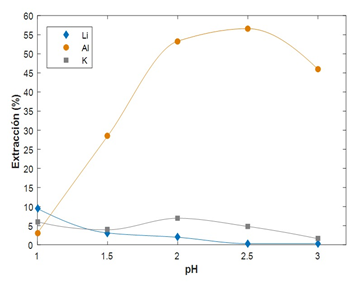Analysis of the Extractants CYANEX 272 and CYANEX 926p for the Extraction of Lithium Ion
DOI:
https://doi.org/10.36790/epistemus.v16i32.216Keywords:
Lithium, Cyanex 272, Cyanex 936P, solvent extractionAbstract
Lithium-ion recovery has become a constant quest due to the increasing demand for rechargeable batteries. The objective of this work was to evaluate the extractants; Cyanex 272 and Cyanex 936P to determine the extractant with the highest affinity to the Li-ion. The extraction efficiency of both extractants was analyzed using synthetic leaching liquors that contained Li, K, and Al, where the pH and the percentage of concentration of the extractant were evaluated, where it turned out that 10% of Cyanex 936P extractant when in contact with A solution with a pH of 2, obtained 44% extraction of the Li-ion, a comparison of the extractant Cyanex 272 where the same conditions, this obtained 1.93% extraction of the Li-ion.
Downloads
References
Yang, S., Liu, G., Wang, J., Cui, L., & Chen, Y., Recovery of lithium from alkaline brine by solvent extraction with functionalized ionic liquid, Fluid Phase Equilibria, vol. 493, Pages 129-136, 2019, https://doi.org/10.1016/j.fluid.2019.04.015.
Zhao, J. M., Shen, X. Y., Deng, F. L., Wang, F. C., Wu, Y., & Liu, H. Z., Synergistic extraction and separation of valuable metals from waste cathodic material of llithium-ion batteries using CYANEX272 and PC-88a. Separation and purification technology, vol. 78(3), Pages 345-351, 2011, https://doi.org/10.1016/j.seppur.2010.12.024.
Ministerio de Energía y Minería de Argentina, El litio argentino. Situación actual y perspectivas. Recuperado de: www.editorialrn.com.ar, 2017.
Yang, S., Liu, G., Wang, J., Cui, L., & Chen, Y., Recovery of lithium from alkaline brine by solvent extraction with functionalized ionic liquid, Fluid Phase Equilibria, vol. 493, Pages 129-136, 2019, https://doi.org/10.1016/j.fluid.2019.04.015. DOI: https://doi.org/10.1016/j.fluid.2019.04.015
Zhao, J. M., Shen, X. Y., Deng, F. L., Wang, F. C., Wu, Y., & Liu, H. Z., Synergistic extraction and separation of valuable metals from waste cathodic material of llithium-ion batteries using CYANEX272 and PC-88a. Separation and purification technology, vol. 78(3), Pages 345-351, 2011, https://doi.org/10.1016/j.seppur.2010.12.024. DOI: https://doi.org/10.1016/j.seppur.2010.12.024
Ministerio de Energía y Minería de Argentina, El litio argentino. Situación actual y perspectivas. Recuperado de: www.editorialrn.com.ar, 2017.
El-Eswed, B., Sunjuk, M., Al-Degs, Y. S., & Shtaiwi, A., Solvent Extraction of Li+ using Organophosphorus Ligands in the Presence of Ammonia. Separation Science and Technology, vol. 49(9), Pages 1342-1348, 2014, https://doi.org/10.1080/01496395.2013.879665. DOI: https://doi.org/10.1080/01496395.2013.879665
Ritcey, G.M. y Ashbrook, A.W., Solvent Extraction in Process Metallurgy, Elsevier, Cap. 2 Y 3, 1984.
Meshram, P., Pandey, B. D., & Mankhand, T. R., Extraction of lithium from primary and secondary sources by pre-treatment, leaching and separation: a comprehensive review. Hydrometallurgy, vol. 150, Pages 192-208, 2014, https://doi.org/10.1016/j.hydromet.2014.10.012. DOI: https://doi.org/10.1016/j.hydromet.2014.10.012
Solvey, Cyanex 272. Recuperado de: https://www.solvay.com/en/product/cyanex-272, 2021.
Solvey, Cyanex 936P. Recuperado de: https://www.solvay.com/en/product/cyanex-936p, 2021

Downloads
Published
How to Cite
Issue
Section
License
Copyright (c) 2022 EPISTEMUS

This work is licensed under a Creative Commons Attribution-NonCommercial-ShareAlike 4.0 International License.
The magazine acquires the patrimonial rights of the articles only for diffusion without any purpose of profit, without diminishing the own rights of authorship.
The authors are the legitimate owners of the intellectual property rights of their respective articles, and in such quality, by sending their texts they express their desire to collaborate with the Epistemus Magazine, published biannually by the University of Sonora.
Therefore, freely, voluntarily and free of charge, once accepted the article for publication, they give their rights to the University of Sonora for the University of Sonora to edit, publish, distribute and make available through intranets, Internet or CD said work, without any limitation of form or time, as long as it is non-profit and with the express obligation to respect and mention the credit that corresponds to the authors in any use that is made of it.
It is understood that this authorization is not an assignment or transmission of any of your economic rights in favor of the said institution. The University of Sonora guarantees the right to reproduce the contribution by any means in which you are the author, subject to the credit being granted corresponding to the original publication of the contribution in Epistemus.
Unless otherwise indicated, all the contents of the electronic edition are distributed under a license for use and Creative Commons — Attribution-NonCommercial-ShareAlike 4.0 International — (CC BY-NC-SA 4.0) You can consult here the informative version and the legal text of the license. This circumstance must be expressly stated in this way when necessary.
The names and email addresses entered in this journal will be used exclusively for the purposes established in it and will not be provided to third parties or for their use for other purposes.














